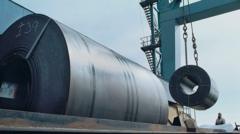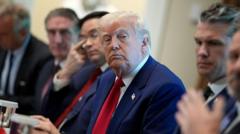**The recent hike in tariffs on steel and aluminum imports to 50% has raised alarms among businesses reliant on these materials, as costs are expected to be passed on to consumers.**
**Increased Tariffs on Steel and Aluminum Impact U.S. Industries**

**Increased Tariffs on Steel and Aluminum Impact U.S. Industries**
**New tariffs imposed on steel and aluminum imports are set to raise costs for various American industries and consumers.**
The recent escalation in tariffs on steel and aluminum imports, surged to 50% as announced by President Trump, is poised to impact a wide range of industries across the United States. The increase follows a prior 25% tariff imposed just months earlier, aimed at bolstering domestic steel production. This latest move, however, has drawn criticism from leaders in the home building, automotive, and manufacturing sectors, who fear significant price hikes for consumers.
Mary E. Lovely, a senior fellow at the Peterson Institute for International Economics, pointed out the substantial effects of these tariffs on consumer goods, stating, “It means higher costs for consumers.” The construction of homes, manufacturing of cars, oil production, and canning are just some of the industries expected to feel the pinch. These businesses are faced with the likelihood of passing increased costs directly onto their customers, further amplifying economic pressures.
While the American Steel Makers have welcomed the steeper tariffs, considering them vital for enhancing competitiveness against foreign imports from countries like China, this sentiment isn’t universal. Kevin Dempsey, president and CEO of the American Iron and Steel Institute, commended the tariff increase as an opportunity to spur local investment and job creation. Yet, many domestic companies argue that such actions merely stifle market competition and inflate the prices they pay for essential materials.
As the situation unfolds, many predict that consumer goods will become more expensive due to these tariffs, signaling a challenge for both businesses and consumers in an already strained economy. The potential 'flood' of cheap steel into the European market has also been highlighted, raising additional concerns over global trade dynamics. The balancing act between supporting domestic industries and protective tariffs continues to spark heated debate in the economic landscape.
Mary E. Lovely, a senior fellow at the Peterson Institute for International Economics, pointed out the substantial effects of these tariffs on consumer goods, stating, “It means higher costs for consumers.” The construction of homes, manufacturing of cars, oil production, and canning are just some of the industries expected to feel the pinch. These businesses are faced with the likelihood of passing increased costs directly onto their customers, further amplifying economic pressures.
While the American Steel Makers have welcomed the steeper tariffs, considering them vital for enhancing competitiveness against foreign imports from countries like China, this sentiment isn’t universal. Kevin Dempsey, president and CEO of the American Iron and Steel Institute, commended the tariff increase as an opportunity to spur local investment and job creation. Yet, many domestic companies argue that such actions merely stifle market competition and inflate the prices they pay for essential materials.
As the situation unfolds, many predict that consumer goods will become more expensive due to these tariffs, signaling a challenge for both businesses and consumers in an already strained economy. The potential 'flood' of cheap steel into the European market has also been highlighted, raising additional concerns over global trade dynamics. The balancing act between supporting domestic industries and protective tariffs continues to spark heated debate in the economic landscape.






















